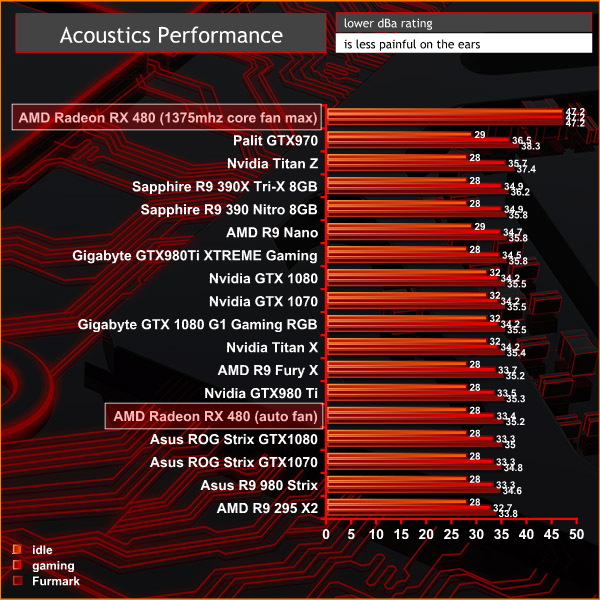We have built a system inside a Lian Li chassis with no case fans and have used a fanless cooler on our CPU. The motherboard is also passively cooled. This gives us a build with almost completely passive cooling and it means we can measure noise of just the graphics card inside the system when we run looped 3dMark tests.
We measure from a distance of around 1 meter from the closed chassis and 4 foot from the ground to mirror a real world situation. Ambient noise in the room measures close to the limits of our sound meter at 28dBa. Why do this? Well this means we can eliminate secondary noise pollution in the test room and concentrate on only the video card. It also brings us slightly closer to industry standards, such as DIN 45635.
KitGuru noise guide
10dBA – Normal Breathing/Rustling Leaves
20-25dBA – Whisper
30dBA – High Quality Computer fan
40dBA – A Bubbling Brook, or a Refrigerator
50dBA – Normal Conversation
60dBA – Laughter
70dBA – Vacuum Cleaner or Hairdryer
80dBA – City Traffic or a Garbage Disposal
90dBA – Motorcycle or Lawnmower
100dBA – MP3 player at maximum output
110dBA – Orchestra
120dBA – Front row rock concert/Jet Engine
130dBA – Threshold of Pain
140dBA – Military Jet takeoff/Gunshot (close range)
160dBA – Instant Perforation of eardrum

We test with the automatic fan profile at the default clock speeds and at 100% when we overclock the RX 480 reference board, to the limit. Fan speeds increase between these two settings from 2,200 rpm under load to a constant 5,100 rpm.
When the RX 480 is set at default clock speeds with the fan profile set to automatic, it is actually relatively quiet, although I could always hear the hum of the small single fan under load. There is a specific, somewhat annoying pitch evident with these blower style fans that AMD have been using for years. I have been mentioning it in my reviews for years, but it falls on deaf ears.
When we overclock the RX 480 to breaking point we pushed the fans to 5,100rpm, the maximum setting. This created noise levels of 47.2dBa which is in all honesty, very painful. I could even hear the fan spinning with headphones on.
We didn't notice any coil whine at all from the card, which is reassuring, although with the fan on 100% we really could hear very little.
 KitGuru KitGuru.net – Tech News | Hardware News | Hardware Reviews | IOS | Mobile | Gaming | Graphics Cards
KitGuru KitGuru.net – Tech News | Hardware News | Hardware Reviews | IOS | Mobile | Gaming | Graphics Cards


